
Of all the cities in Europe, Berlin is one of the most complex. Home to some of the most famous monuments in recent history, there is much more to Berlin than its infamous wall. The grey concrete constructions on the formerly socialist eastern side are now adorned with kaleidoscopic street art, reflecting this new age of creative expression. Museums telling the city’s emotive history sit side-by-side with vibrant parks embracing drum circles, outdoor karaoke and experimental breweries. Even the traffic lights are interesting, with the iconic Ampelmann and his little hat guiding pedestrians across eastern Berlin since the 1960s. This combination of gritty and glorious is reminiscent of a festival site before the music starts: bursting with potential and full of hidden gems just waiting to be discovered.
Located in the ever-evolving Friedrichshain-Kreuzberg District, locomotive repairs were carried out at this former industrial site from 1867 up to the fall of the Berlin Wall. The Reichsbahn-Ausbesserungs-Werk (“RAW”) site gradually fell into disrepair during the nineties but began its new life as a cultural hub in the early 2000s, with various artistic and commercial institutions making their home there.
Its many changes of ownership have now left it divided between a small strip used to repair Spanish night trains and three larger areas owned by investment companies, from whom the artists lease their studios directly. However, these relationships are strained by the dichotomy between the investors’ desire for urban development and the creatives’ commitment to retaining the history and authenticity of the area, resulting in ongoing resistance to various plans for high-rise buildings on the site.
The future is uncertain but for now, RAW continues to exude that particular Berlin brand of cool, housing art exhibitions, studios, beer gardens, clubs, an indoor skate park and a climbing wall on a former World War II bunker (known as Der Kegel or “the cone”).
Some of its more eclectic features include a Photoautomat that is old enough to be trendy again and a Teledisko, a tiny dance club the size of a phone booth where visitors can pay a couple of euro to pick their song and enjoy a miniature dance party.
From its less than auspicious beginnings as a collection of tents on the dusty banks of the river Spree, Holzmarkt 25 has developed from the site of an initially tiny techno club – the now closed but at one point internationally famous Bar25 – into a cooperative hub dedicated to sustainability and the creative arts.
Successfully resisting political pressure and urban development, the complex opened in 2017 and now houses a diverse range of entertainment for visitors, from yoga, day care, restaurants, bars, two theatre stages and another of Berlin’s famous Telediskos. The murals adorning the walls are some of the most colourful in the city and the wooden jetty with a dedicated “beaver exit” is the ideal place to relax and people-watch with a cold beer in hand.
Its activities are not just restricted to summertime – the annual Christmas market held here flies under the radar of most tourists and perhaps because of this, it makes for a unique festive experience.
Since 1990, some of the most famous murals in the world cover the longest preserved piece of the Berlin Wall, the 1.3km known as the “East Side Gallery”. However, this is not the only reason that Berlin is known as the street art capital of the world and for those looking to discover lesser-known street art, the area around Bülowstrasse is home to a number of incredibly detailed pieces that deserve to be appreciated.
Recognising the ephemeral nature of street art, the Urban Nation Museum was founded at a former furniture shop at Bülowstrasse 7 in 2017, celebrating the temporary nature of this medium with ever-changing exhibits while also showcasing its history and promoting it worldwide by inviting artistic collaborations with acclaimed and aspiring artists, both inside and outside the museum. Entrance to the museum is free and it is open every day except Monday.
In the heart of the former no-man’s-land between the east and west sides of the Berlin Wall, 16 trees stand as a solemn memorial against violence and war, created by artist and environmental activist, Ben Wagin. Each tree represents one of the 16 states that formed unified Germany after the fall of the Wall and was planted by the minister-president of that state.
Created in 1990 on the eastern shore of the river Spree and sitting opposite the German Parliament, the unconventional garden in the former “death strip” contains 58 pieces from the Wall itself, listing the names of its 258 victims by the year in which they died.
These slabs are accompanied by photos, flowers and memorial stones, along with texts and testimonials. With the construction of the Marie-Elisabeth-Lüders-Haus in 2003, the Parliament of Trees was reduced in size but survived the upheaval and remains as an almost tourist-free contemplative space just off the busy Schiffbauerdamm promenade.
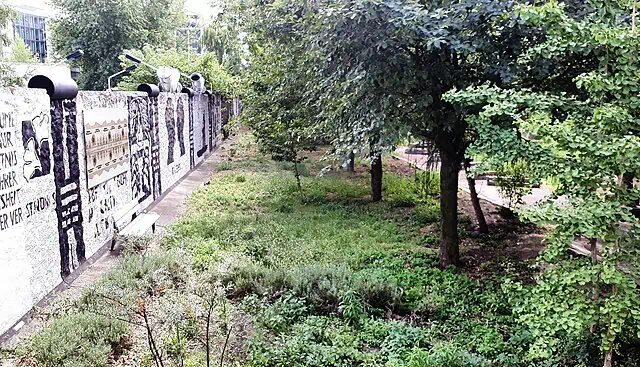
Parliament of Trees
photography by: Fridolin freudenfett/ Wikimedia Commons
Translated directly as “Wall Park”, Mauerpark is located at the border of Prenzlauer Berg in former East Berlin and the Gesundbrunnen district of former West Berlin. This history lives on in an 800m stretch of the Wall located in the park, now used by graffiti artists to showcase their work.
While this remnant of the area’s tragic history remains, visiting the park on a Sunday is nothing short of an exercise to restore faith in humanity and celebrate creative endeavours.
This is largely due to the electric atmosphere created within a stone amphitheatre, where Bearpit Karaoke began in 2009 and continues to attract people from all walks of life. A young girl singing Frank Sinatra could easily be followed by an old man singing Ariana Grande and that’s what makes this place special – everyone is welcome, regardless of age, gender or even musical talent.
Created and hosted by Joe Hatchiban and his battery-powered speakers, his humorous comments and solo performances alone are worthwhile watching. The park also hosts drum circles where passers-by are welcome to join and a popular Sunday flea market selling a variety of vintage fashion, vinyls and various other novelties.
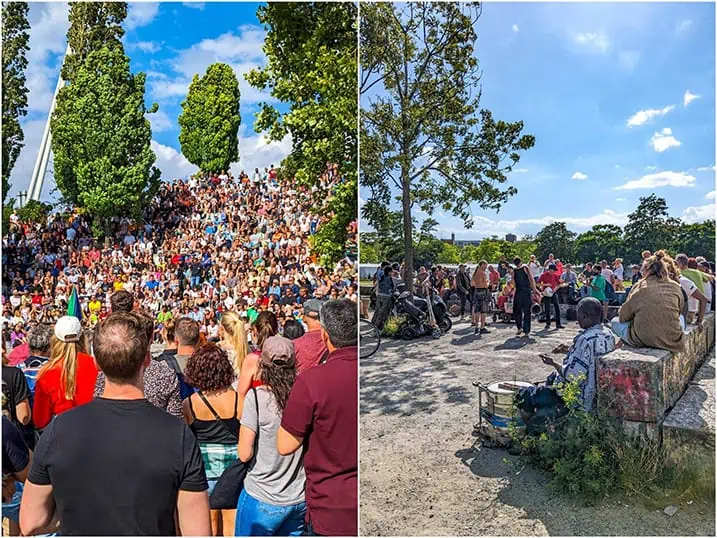
Karaoke and a drum circle at Mauerpark
photography by: Sinéad Browne
Located just south of Central Berlin, Treptower park sprawls across 84 hectares meaning that even on a busy summer’s day, there is always a hidden nook to escape the city in this green oasis. Opened in 1888, it was innovative in many ways because not only was it open to all the city’s inhabitants, it also gave these residents the chance to explore their city in a different way, travelling by boat along the river Spree.
Boat rentals and cruises are still available today and for those looking for less sedentary activities, the waterside park is ideal for cycling, running or even swimming in the somewhat swampy lake.
Notable features of the park include live music shows on Insel der Jugend (“Island of Youth”), a huge Soviet War Memorial where 5,000 Soviet soldiers are buried and the Archenhold Sternwarte, where the world’s longest refracting telescope can be found. Close to the observatory and the war memorial, the Ferris wheel from the former Spreepark amusement park can be heard creaking in the wind, heralding the demise of the now abandoned site that continues to fascinate UrbEx adventurers.
Capturing the essence of the Kreuzberg neighbourhood, Markethalle Neun celebrates the diverse community of the area on Thursday evenings with a range of eclectic street food stalls to tickle international tastebuds, from wild oysters to artisan cheese and even spaghetti ice-cream.
Because it is well-known to locals, it is likely to be crowded but not in the way tourist hotspots are and it is an ideal opportunity to mingle with Berliners and soak in the pre-weekend atmosphere. The market hall itself is steeped in history, dating back to 1891 and restored in 2011 following a successful campaign to prevent the structure being demolished.
While Street Food Thursday is the best way to enjoy the local culture, the indoor market hosts several other events including an organic produce market on Saturdays, a breakfast market on the third Sunday of the month and annual celebrations such as the Sausage & Beer Festival.
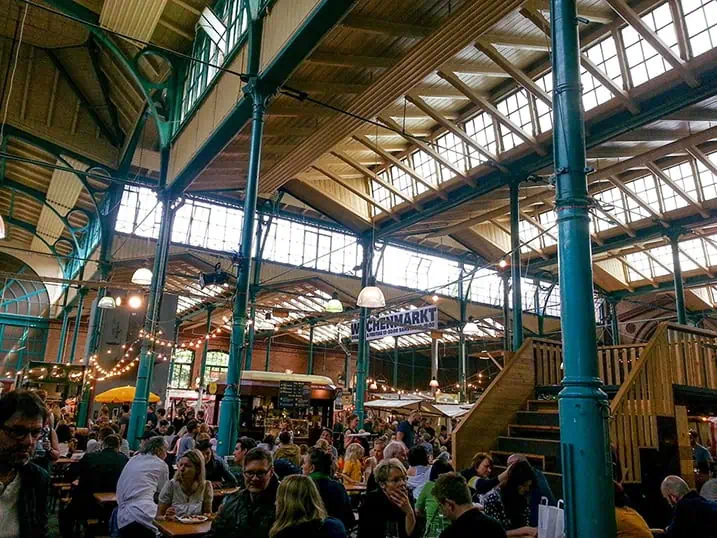
Markethalle Neun
photography by: Dan Dickinson/ Flickr
In a city famous for its nightlife, it is no surprise that Berlin is home to some of the world’s best bars, any number of which could be considered hidden gems. One in particular stands out due to its construction and its obscure location, on the rooftop of the Neukölln Arcaden shopping centre beside Rathaus Neukölln station.
Unlike sky bars in other cities, this watering hole is gloriously unpretentious and while there is a cover charge to enter, its views justify this, especially if you can catch a sunset here. While closed in winter, Klunkerkranich’s summer programme is extensive, with an outdoor area carefully cultivated by urban gardening enthusiasts while inside, strains of electronic dance, techno, jam sessions and DJ sets can be heard emanating from the cosy bar and the parking-deck club.
The bar is accessed through the mall, via a lift to the top floor of the car park from where chalk arrows point the way towards this evening oasis.
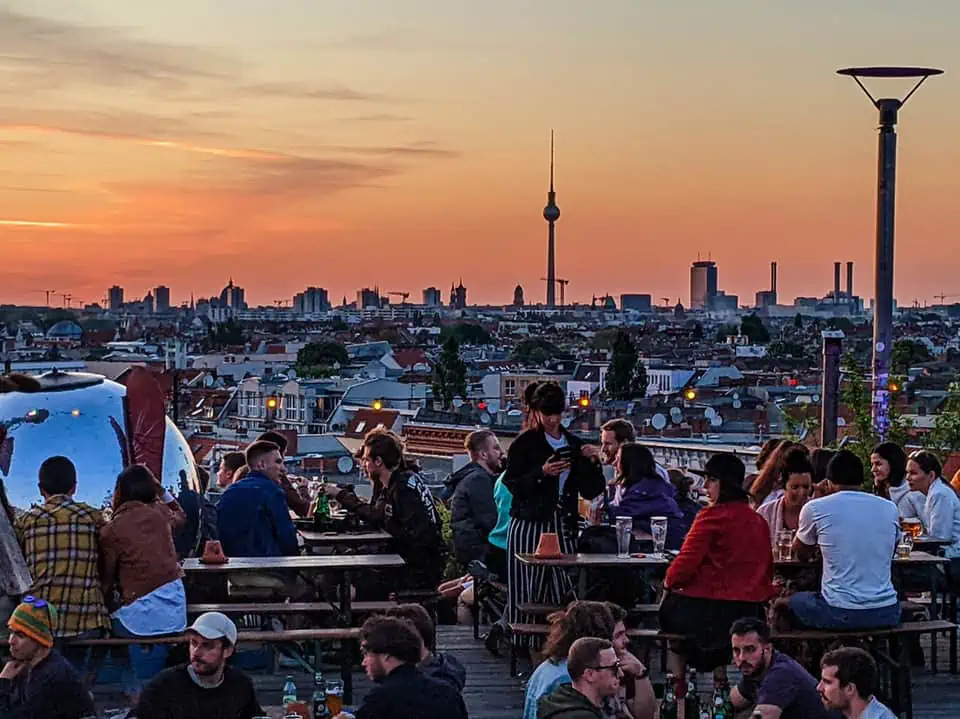
Klunkerkranich bar at sunset
photography by: Mitch Altman/ Flickr
Although born in Baltimore in the US, David Hasselhoff fortified his German roots and became something of an icon in the country when he performed his song ‘Looking for Freedom’ on New Year’s Eve 1989, hoisted by a crane above the remnants of the Berlin Wall.
The song became an anthem for reunification and “The Hoff” has regularly performed in the city since, including a “30 Years of Freedom” concert in 2019. All of this is celebrated in a tiny 2×1-metre museum in the basement of The Circus Hostel in Mitte, packed with memorabilia from the actor-singer’s career and cementing his connection to the country.
At 1pm every Wednesday between September and June, the foyer of the main auditorium of the Berlin Philharmonie fills up with an excited audience there to enjoy a unique experience: a 40 to 50-minute lunchtime show featuring a range of classical music from some of the city’s finest musicians.
Located to the south of Tiergarten at the periphery of former West Berlin, the bright yellow building is a city landmark and while the free concerts are well known to locals, they escape the attention of most visitors. Places are limited to 1500 so it is best to arrive early and the full programme of events is available on the Berliner Philharmoniker website.
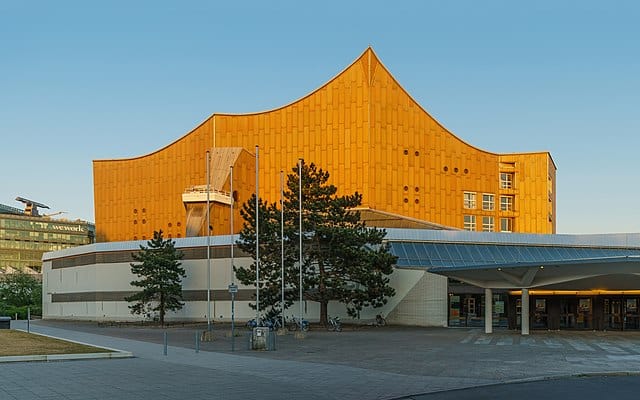
Berlin Philharmonie
photography by: A.Savin/ Wikimedia Commons
Popular with locals but almost unknown to tourists, Viktoriapark boasts the highest hill in central Berlin, called Kreuzberg (“Cross Hill”) and offering great views of the surrounding city. From these lofty heights, the panorama includes the skyscrapers of Potsdamer Platz, Tiergarten’s golden Victory Column, the redeveloped former brewery complex of Berliner Brauerei-Gesellschaft Tivoli and the large water tank belonging to Tempelhofer Feld, Berlin’s old inner-city airport and now Berlin’s newest and largest (355 hectares) park.
This 66-metre hill was used to cultivate vines up to the 18th century, giving rise to its old name, Runder Weinberg or “Round Vineyard”. Its current name, later adopted as the name for this whole region of Berlin, derives from the cast-iron structure atop the hill, a national monument dedicated in 1821 and celebrating Napoleon’s defeat and the liberation of Europe.
Wishing to enhance the surroundings of the park named after his wife, Kaiser Friedrich III commissioned the development of an urban waterfall at the foot of monument in 1888, modelled on the Krkonoše mountains on the Polish-Czech border. This 24-metre-high water feature was eventually completed in 1894 and accurately emulates its archetype, with its surrounding rocks providing an ideal place to relax on a hot summer’s day.
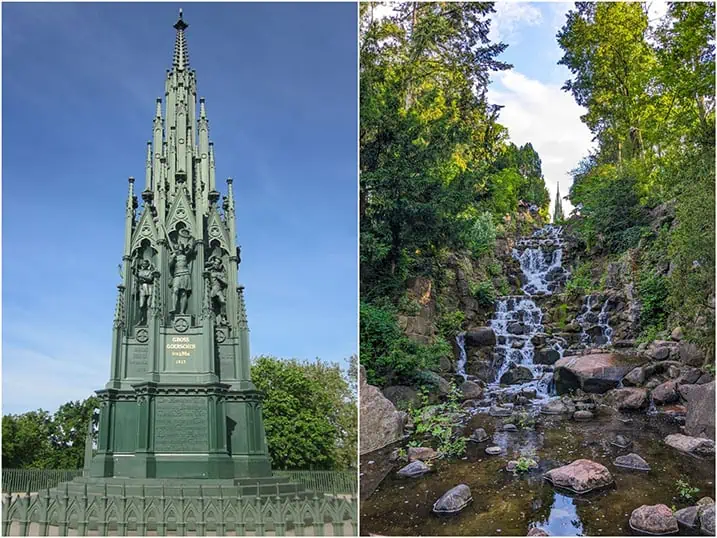
National Monument for the Liberation Wars and waterfall at Viktoriapark
photography by: Lear 21/ Wikimedia Commons (L) and Sinéad Browne (R)
Located in the eastern district of Marzahn-Hellersdorf, Wolkenhain translates as “cloud grove” and with a little imagination, the slender white columns and irregular shape of this viewing platform resemble exactly that. Completed in 2017 and perched on a 102m hill, the landmark offers views of downtown Berlin and even as far as the western outskirts of the city on a clear day.
While the views alone make a visit here worthwhile, the story of the mound is fascinating. Standing at only 66m tall in 1966, subsequent decades of dumping construction waste and soil led to the mountain almost doubling in height, providing the ideal location for such a unique construction.

Wolkenhain Viewing Platform
photography by: a2 d2/ Flickr